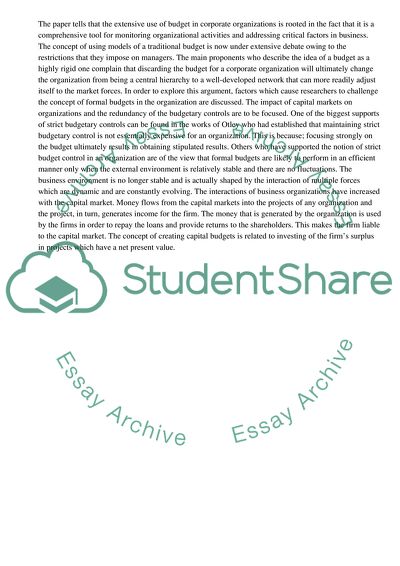Cite this document
(“Traditional Budget Is a Rigid Tool and Should Be Discarded In Practice Essay”, n.d.)
Traditional Budget Is a Rigid Tool and Should Be Discarded In Practice Essay. Retrieved from https://studentshare.org/management/1665957-the-traditional-budget-is-a-rigid-tool-and-should-therefore-be-discarded-in-practice-should-the-traditional-budgetary-model-be-abandoned-as-suggested-above-critically-evaluate-this-claim-in-the-light-of-recent-external-pressures-from-the-capital-mark
Traditional Budget Is a Rigid Tool and Should Be Discarded In Practice Essay. Retrieved from https://studentshare.org/management/1665957-the-traditional-budget-is-a-rigid-tool-and-should-therefore-be-discarded-in-practice-should-the-traditional-budgetary-model-be-abandoned-as-suggested-above-critically-evaluate-this-claim-in-the-light-of-recent-external-pressures-from-the-capital-mark
(Traditional Budget Is a Rigid Tool and Should Be Discarded In Practice Essay)
Traditional Budget Is a Rigid Tool and Should Be Discarded In Practice Essay. https://studentshare.org/management/1665957-the-traditional-budget-is-a-rigid-tool-and-should-therefore-be-discarded-in-practice-should-the-traditional-budgetary-model-be-abandoned-as-suggested-above-critically-evaluate-this-claim-in-the-light-of-recent-external-pressures-from-the-capital-mark.
Traditional Budget Is a Rigid Tool and Should Be Discarded In Practice Essay. https://studentshare.org/management/1665957-the-traditional-budget-is-a-rigid-tool-and-should-therefore-be-discarded-in-practice-should-the-traditional-budgetary-model-be-abandoned-as-suggested-above-critically-evaluate-this-claim-in-the-light-of-recent-external-pressures-from-the-capital-mark.
“Traditional Budget Is a Rigid Tool and Should Be Discarded In Practice Essay”, n.d. https://studentshare.org/management/1665957-the-traditional-budget-is-a-rigid-tool-and-should-therefore-be-discarded-in-practice-should-the-traditional-budgetary-model-be-abandoned-as-suggested-above-critically-evaluate-this-claim-in-the-light-of-recent-external-pressures-from-the-capital-mark.


